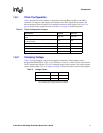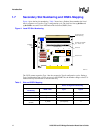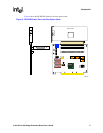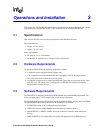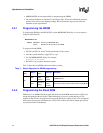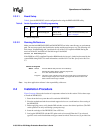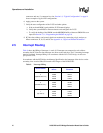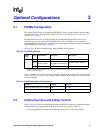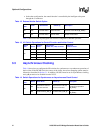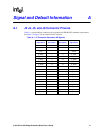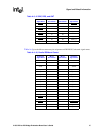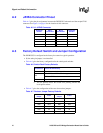
22 21555 PCI-to-PCI Bridge Evaluation Board User’s Guide
Optional Configurations
• In the other configuration, the central function is controlled by the intelligent subsystem
through the J1 connector.
Table 13 shows how the req# and gnt # lines must be configured for PICMG operation.
3.3 Asynchronous Clocking
Table 14 shows how to configure the J20 switches for synchronous or asynchronous operations of
the local bus. If the PICMG slot is the source of the clocks, the resistor strapping options must be
followed as described in Section 3.1. In addition, J20 SW3 must be set for asynchronous clocking
and s_clk_o needs to be disabled from the 21555.
Table 12. External Arbiter Switch Option
Switch
Pack
Switch Switch Down Switch Up Description
J20 SW5
Enable the 21555
as central arbiter
System slot (J102) as
Central Function
Central Function Mode(pr_ad<6>)
J21 SW1
Disable the 21555
as central arbiter
System slot (J102) as
external arbiter.
Disable 21555 arbiter.
Table 13. J21 Switch Operations for Central Function and Arbiter Control
Switch
Pack
Switch
Request/
Grant
Switch Down
System slot (J102) as arbiter
Switch Up
21555 as arbiter
J21
SW2 req#0 PICMG GNT becomes slot grant req=req
SW3 gnt#0 PICMG REQ becomes slot grant gnt=gnt
SW4 req#1 REQ1 from PICMG slot REQ1 from drawbridge
SW5 gnt#1 GNT1 from PICMG slot GNT1 from drawbridge
Table 14. Switch Operations for Synchronous or Asynchronous Clock Control
Switch
Pack
Switch Switch Down Switch Up Description
J20
SW3
Synchronous host and
local clock domains
Asynchronous host and
local clock domains
Selects synchronous or
asynchronous operation.
(pr_ad<4>)
SW4 Disable 21555 (s_clk_o) Enable 21555 (s_clk_o)
s_clk_o
(pr_ad<5>)



